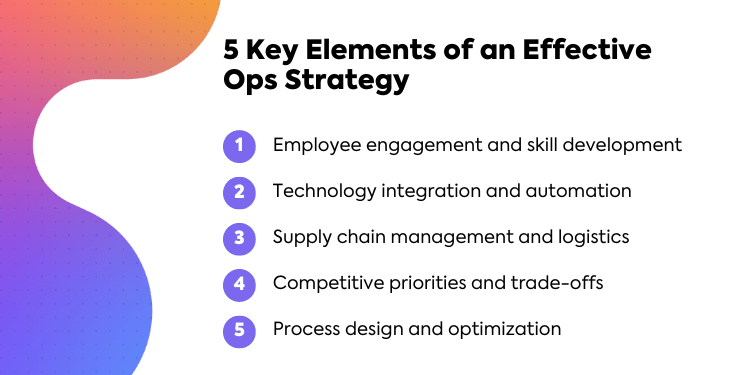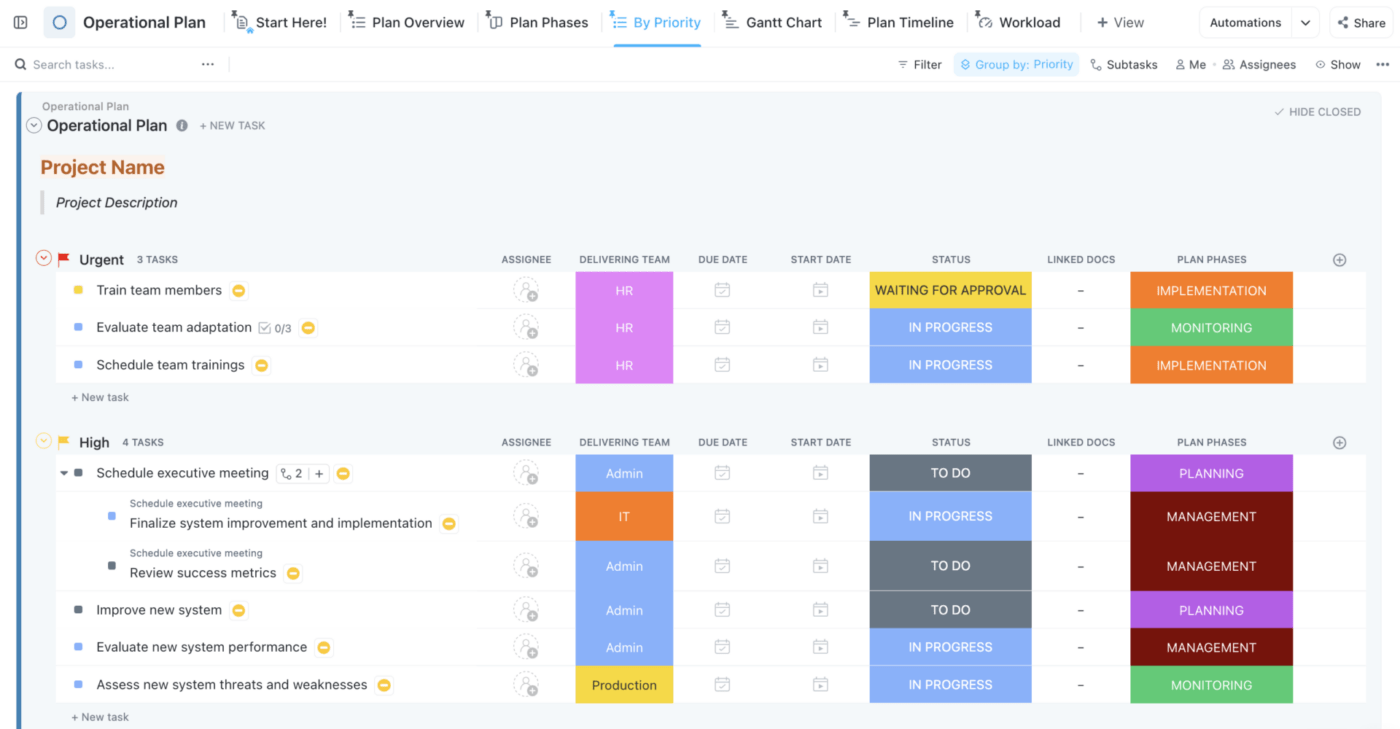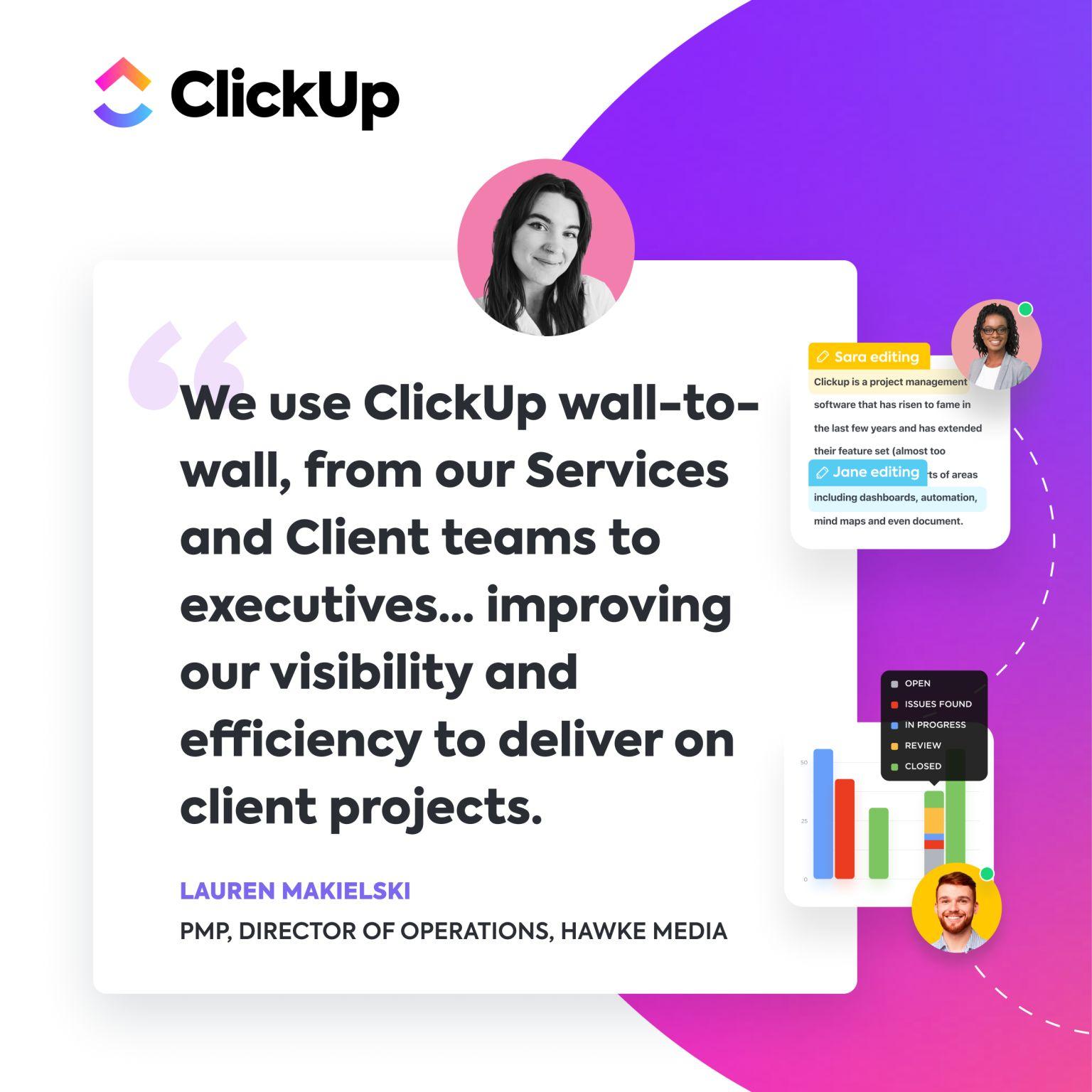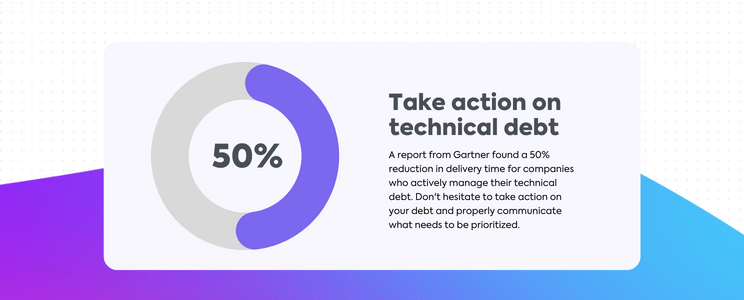A Framework to Design an Effective Operations Strategy

Sorry, there were no results found for “”
Sorry, there were no results found for “”
Sorry, there were no results found for “”
Why do some companies align on strategic priorities and operate at peak efficiency while others have a stockpile of unsuccessful projects?
The short answer is the shelf life of an operations strategy hinges on day-to-day implementation.
In a 2023 ClickUp global survey of hundreds of business leaders, 35% of respondents said operational efficiency is their top focus for business success. This is a call to action for Outcome Champions—operations management professionals coordinating resources, processes, and people to achieve operational excellence. ✨
The fundamental question to ask before taking any steps is a two-parter: What are your organization’s logistical and culturally relevant strategies, and how do you sustain a best-in-class partnership between all leadership levels and teams for success?
Building strategies isn’t just about solving problems. Instead, it should leverage the capabilities of technology and build a workplace that removes fear-based opinions about trying new ideas. And that type of innovation is fuel for both strategic work and production.

Operations strategy is the actionable plan that guides how a company manages its processes and resources in alignment with its overarching organizational goals. These processes involve the production and delivery of products or services that the company offers.
Beyond the jargon, there’s a concept that molds a workplace’s culture, productivity, and business goals. Any company—small, mid, and large—does this to fit what they’re doing, where they’re doing it, and how they want to be different from others in their field.
While it could be perceived as an overlap with strategic planning, there is a distinction to be mindful of as we explore this guide: Strategic planning sets the overall vision and direction for the organization, often done annually or semi-annually. The operation’s main goals describe the processes and workflows that will be used to complete the work. ⚙️
Let’s take a look at operation strategy examples of specific functional areas within the organization:
| Strategy Type | Achievements |
|---|---|
| Core competency strategies | Harnesses a company’s unique strengths to gain competitive advantage, focusing on distinct skills or technologies that define business success |
| Cost leadership strategies | Aims to be the industry’s lowest-cost provider, offering quality products or services at prices lower than competitors |
| Customer-driven strategies | Integrates technology for efficiency, agility, and customer experience by adopting cloud computing, data analytics, automation, and digital reporting tools |
| Differentiation/Competitive strategies | Distinguishes a product or service, aiming for perceived quality, unique features, and customer loyalty to justify premium pricing |
| Digital transformation strategies | Drives growth through continuous improvement, fostering creativity, and investing in research and development to stay competitive and relevant |
| Employee engagement strategies | Nurtures a motivated, committed workforce by fostering a positive culture, enabling growth, and involving employees in decisions |
| Inventory operations strategies | Includes various aspects of inventory management (procurement, storage, distribution, and optimization), so the right quantity of goods is available at the right time, place, and cost |
| Operational excellence strategies | Optimizes processes for efficiency, cost-effectiveness, and quality, driven by continuous improvement methods such as Lean Six Sigma |
| Outsourcing strategies | Contracts tasks to external providers, reducing costs, accessing expertise, and allowing internal teams to focus on core business activities |
| Product or service strategies | Focuses on creating products or services that exceed expectations by optimizing the entire lifecycle, from concept to post-launch support |
| Risk management strategies | Safeguards a business by identifying, assessing, and mitigating potential risks through control measures and contingency plans |
These operations strategies are not mutually exclusive. And this is good news! No one wants to be locked into a single business strategy. An integrated approach lets organizations optimize their operations for different products/services, customer segments, and markets. 🎯
When an organization invests in operations strategy and implementation, it invests in employee productivity. With a direct line of sight to the why and how behind their tasks, they aren’t forced to navigate high levels of ambiguity.
Instead, they are prepped with clear instructions to complete the right tasks.
If you’re eager to begin process mining and outline your operational objectives right now, download the Operational Plan Template by ClickUp. It’s time to declutter your mental garage to make space for exciting, growth-oriented projects.
Extend invitations to your nearest collaborators and organize a systems architecture workshop, whether in real-time or asynchronously! 📧

So far, we’ve learned the inner workings of an operations strategy. Let’s see this in practice.
This compact guidebook is built for an operations manager to implement the best core business processes and workflows into project plans.
So, why is this guide compact? Disclaimer: We’re all in the same sitcom but reading different scripts. While there are business models and industries we can sort ourselves into, every company has a different set of core values that reflect its purpose and guiding principles.
For this reason, the systems you’ll read below are the key success factors all operational strategies need. Teams can reach their peak performance by putting just one insight into action!

Think short-term perspective (competitive priorities) and long-term vision (trade-offs).
Short-term planning meets immediate customer requirements, helps allocate resources at the right place and time, and provides benchmarks for evaluating team performance.
Long-term planning allows organizations to invest in modern technology solutions, guide market expansion opportunities, and redesign logistics.
Your operational plan should have a narrower scope and be concerned with the day-to-day activities and actions necessary to implement the strategic plan. The key to securing leadership approval and support is articulating your plan’s value, feasibility, and alignment.
This is where co-creating easily measurable KPIs with teams and all levels of leadership is essential to provide each team member with a sense of ownership in their tasks. 🔑

Putting together a task force for the operations strategy is a group effort, especially when partnering with other teams. Collaborators in finance, marketing, human resources, and more will help fill knowledge gaps and advocate for enhancing efficiency, reducing costs, and delivering greater value.
Every department has business-as-usual tasks that keep the ship moving. If your operations strategy requires a significant chunk of time, there needs to be conversations with department leads about the best approach to minimize disruption. 💬
Because operation managers have a complex and multifaceted role, these discussions are teachable moments to influence the outcome of projects.
Three valuable tools—capacity planning, resource planning, and process mapping—will take the guesswork out of this step.
This action plan will take multiple rounds to finish, but it won’t be complete even then because priorities may evolve as circumstances change. The best safeguard for transparency in any shift in the strategy is having a single source of truth to revisit and make micro-adjustments. ⚖️
The contents of your action plan will vary based on your company’s business model and operational processes. At minimum, the contents of your action plan document should include:
| Section | Content |
|---|---|
| Title | Start with a memorable name that reflects the operational strategy’s impact or focus |
| Introduction | Provide a brief overview of the operational strategy, its objectives, and why it’s relevant to the corporate strategy goals |
| Executive Summary | Summarize the key highlights of the action plan, including prioritized objectives, task owners/contributors, timelines, and expected outcomes |
| High-Level Tasks and Initiatives | Break down the scale and scope of the tasks or initiatives required for implementation |
| Responsible Teams | Designate accountability of department heads/individual contributors who will be responsible for any project communication updates, reviews, and approvals |
| Timelines and Milestones | Outline specific timelines for key activities, deliverables, and quality control checkpoints that signify actual progress |
| Dependencies | Highlight tasks that must be completed before others can begin and address how dependencies will be managed to prevent delays |
| Resource Allocation | Detail the allocation of resources, including budget, staff, technology, and materials. List any resource constraints, if there are any! |
| Risk Assessment and Mitigation | Identify potential risks and challenges with contingency plans |
| Communication and Stakeholder Engagement | Describe the communication plan for keeping all stakeholders informed and the level of stakeholder engagement |
| Attachments | Include any supporting documents, research, and relevant projects |
| Reporting and Monitoring | Specify the metrics and KPIs that will be used to measure progress and success |
| Budget and Financial Planning | Add the financial resources allocated to each task or initiative |
If it feels as if the universe gets bored and starts making things happen on its own because it takes you over a week to draft an action plan, try ClickUp AI. We’ve covered you with 100+ tools that use research-based prompts tailored to specific roles! 🤖

Are teams feeling comfortable sharing their ideas, concerns, and feedback? Is there a rise in delayed projects because of a lack of accountability? Are team members asking, “What should I do today?”
Your leadership, communication, and problem-solving skills are essential to the operation strategy’s success. Because you’re working between different teams, you’ll have to organize assorted information that’s coming at you from different channels. 👨💻
You’ll need the right task management container to set everyone up for success and communicate expectations for executing projects. If you think the action plan you wrote in step 3 will be “good enough,” consider this:
Managing tasks through a static action plan can overwhelm larger teams or complex projects. There’s too much noise and clutter to scroll through daily. Dedicated task and project management software sets the stage for individual and team productivity at scale.
Manual models can’t keep up with the demands of an agile workforce, and being agile is a non-negotiable in today’s marketplace as industry-tailored AI use cases continue to grow. Your time and attention should be spent on high-value tasks and activities that move teams closer to their goals.

Take a quick water break, then download the Daily Action Plan Template by ClickUp. This template has all the ingredients to organize task assignments, milestones, deadlines, and contributors.
As ClickUp users, your teams and stakeholders have all the tasks and documentation within reach to monitor progress closely throughout the implementation phase!
It’s easy to underestimate the impact of small, seemingly mundane tasks that accrue over time. However, these “save for later” tasks can quickly snowball into a significant team problem.
Let’s take a closer look at the hidden costs of shortcuts:

Tackling any debt is a team effort. Here are a few quick methods to pull out of your productivity toolbox and tackle small tasks for minimum impact on your production initiatives:
Now, back to our regularly scheduled program! 🎬
Considering that other routine tasks and special projects are running simultaneously in your workload, how do you maintain group momentum in the operations plan?
Begin with questions to help the operations management team systematically gather and analyze data on a centralized dashboard. This will reduce cognitive burden and allow team members to make confident decisions.
These checklists and rules can be as detailed as you need them to be for internal use. If it helps to assess their true usefulness, run it through a beneficiary test. Give them to project leads, stakeholders, and senior leadership to confirm whether or not they’re focusing on the right questions to evaluate day-to-day implementation. 📊
So, how can operations managers apply checklists and decision rules on a tactical level when they’re up against tight timelines?
Deliver a consistent experience to your team with a scheduled routine.
Here’s a breakdown of operational strategy tasks at intervals. Is there anything you notice that can be added to your personal or team schedule? 🗓️
| Frequency | Action Items |
|---|---|
| Daily tasks | Hold brief daily meetings or huddles with project leads to discuss progress, challenges, and goals for the day/week Address issues or roadblocks diligently to prevent them from escalating into more significant problems Review daily progress and check for any critical issues or bottlenecks Continuously monitor key performance indicators (KPIs) statuses |
| Weekly tasks | Draft weekly status reports to stakeholders, highlighting project accomplishments, challenges, and upcoming milestones Review resource allocation and workload distribution so teams are balanced, and no one is overloaded Evaluate new risks that have surfaced during the week and update risk mitigation plans Gather feedback from team members about task progress and their experiences Analyze progress against project timelines, budgets, and objectives |
| Monthly tasks | Take notes to develop a continuous improvement plan that outlines specific actions to improve project management processes Host post-project reviews or retrospectives to document lessons learned from completed projects for future reference Consider long-term resource planning and workforce development needs based on the evolving project portfolio Verify that ongoing and upcoming projects align with the organization’s overall strategic goals and priorities Collect and analyze customer and stakeholder feedback on project outcomes and performance Assess whether projects are on track to meet their objectives and make any necessary adjustments to project plans Review project budgets and financial performance |
With your newly acquired operations strategy framework in hand, apply it in the context of your company’s operations and processes. From supply chain management to software and everything in between, you’ll have the tools to coordinate even the toughest operations strategies. 💪
Lastly, if you’ve ever experienced fleeting progress in your responsibilities, it might be because you’re not focusing on the right things at the right time. It’s okay—no, it’s allowed—to ask your peers to challenge your observations when you get stuck.
Count on the team at ClickUp as one of your peers, and reach out if you need help stepping out of a revolving door of unsuccessful implementation. Happy planning! ✍️
© 2025 ClickUp